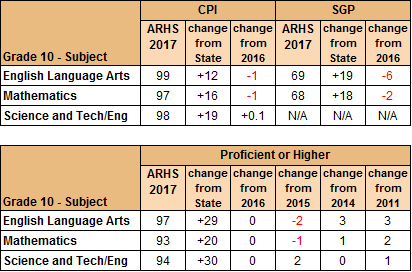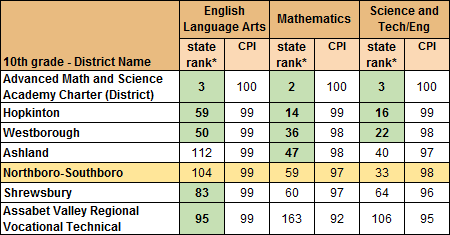Above: Algonquin 10th graders scored well on MCAS compared to the state average and very close with neighboring towns. But ranked against competing neighbors, there’s not a lot to brag about. (photo by Susan Fitzgerald)
Last week, I shared news on Southborough’s MCAS results. I promised to share Algonquin’s results later in the week. I’m finally following through.
The good news is that the 10th graders ranked well compared to the state. And testing was fairly on par with last year. The bad news is that most won’t like how we ranked compared to some other schools.
Most of the scoring for Algonquin was very, very close with higher ranked schools*. So, these rankings probably don’t mean much. But they certainly don’t give ARHS bragging rights vs neighbors.
Some were a bit surprising. The one that shocked me the most was Assabet Valley Regional Technical High School’s outranking of Algonquin on English Language Arts testing.
Here are stats I pulled. First, I took a look at ARHS’ 10th graders’ performance vs the state and compared to past years.

(Scroll down for more detail on this year’s ARHS scores by Advanced, Proficient, etc.)
Next, I looked at rankings vs. neighboring schools that performed higher.

For a better look at results for our 10th grader broken out by scoring groups, click on the table below.

It’s probably important to keep in mind that there is a reason that the state launched a new version of MCAS for the younger grades. 10th graders were given the old, standard test. For more on changes to testing, read my post from last week.
For more data, or to run your own sorts, visit Mass DOE’s results database.
*Ranking methodology: To rank schools, I sorted by highest CPI score, followed by combined Advanced & Proficient %, followed by Advanced %.
CPI = Composite performance index (CPI)
Massachusetts uses the 100-point Composite Performance Index (CPI) to measure progress towards the goal of narrowing proficiency gaps. The CPI assigns 100, 75, 50, 25, or 0 points to each student participating in PARCC, MCAS, and MCAS Alternate Assessment (MCAS-Alt) tests based on how close they came to scoring Proficient or Advanced. (For example, all students scoring Proficient or Advanced are assigned 100 CPI points; students with very low assessment scores are assigned 0 CPI points.) The CPI for a student group is calculated by dividing the total number of points by the number of students in the group. The result is a number between 0 and 100.
SGP = Student Growth Percentiles



Well, let’s see here………..not only is Hopkinton $2K less in student costs, the town significantly outranks Southborough in all three categories. When do the school committees start taking this a little more seriously?
If this is the criteria you judge school success by, then you have a good point. But I’m not sure that MCAS is the best way to judge the school’s ability to prepare students for the outside world after graduation. The Mass Dept of Ed said as much in their explanation for why they are changing the test.
That said, I’m not sure what metrics should be used and who tracks those. I believe there is some tracking for how many students are accepted to college before graduation. But I don’t think there is any tracking of post-graduation success.
There is no tracking of post graduation success that I know of. That should be done. What would be of interest to me is post graduation success of Assabet vs Algonquin. Might seem like apples and oranges to some but if we took look at Assabet students who go to college it could be quite the eye opener. The pursuit of happiness starts with a rewarding job. Having a skill and a college degree would be a large leg up in a competitive world.
You know that definition of being successful after high school is simply a moving target once again and is bull Directed by the NEA in the MTA and the state and federal education cartels. That being said Frank, Southborough is a huge attraction for parents with children with disabilities and challenges. One example is autism and the autism center in Southborough. I would like to see how many special education and special aides Southborough has compared to other school districts. I think there you will find the extra expense. My personal feeling is we should expand all of our trade schools as we have many jobs we can’t fill in my industry and in the trades. Secondly, as we have said for years, we should be allow true school choice where the money from the state and federal government follows the child regardless if they go to private school, charter school, homeschool, or a public high schools which if you think they do a great job that’s where you choose to send your children. That would alleviate a lot of this back-and-forth finger-pointing.
So the guy who consistently rails against “big government” now wants the government to pay for kids to go to private schools. Fascinating.
Dear Ms. Melo,
Why do you find it so surprising that Assabet outranked ARHS in ELA? AVRTHS is a top ranked Technical High School with amazing staff and students. I find your comment insulting and uncalled for.
I’m sorry that you feel offense. But I’m not sorry for making the comment. If I had written that I was shocked the school performed well, you would have reasonable right to take offense. But that’s not what shocked me.
I am aware that AVRTHS is a top ranked “Technical” high school. That’s why I wouldn’t have been shocked to find out that the school outranked ARHS in science and/or math.
But I never see any marketing or press that focuses on a strong english/reading/writing program. (And I get a lot of press releases from the school, and am on the Facebook feed.)
Meanwhile, ARHS touts its award winning newspaper, and literary magazine, has developed a writing center, etc.
It is for those reasons that the ELA ranking shocked me. Assuming that the score accurately reflects that AVRTHS has a strong language arts program, maybe the school needs to start promoting it more.
I’m sorry that you feel offense. But I’m not sorry for making the comment. If I had written that I was shocked the school performed well, you would have reasonable right to take offense. But that’s not what shocked me.
I am aware that AVRTHS is a top ranked “Technical” high school. That’s why I wouldn’t have been shocked to find out that the school outranked ARHS in science and/or math.
But I never see any marketing or press that focuses on a strong english/reading/writing program. (And I get a lot of press releases from the school, and am on the Facebook feed.)
Meanwhile, ARHS holds writing workshops, touts its award winning newspaper, and literary magazine, has developed a writing center, etc.
It is for those reasons that the ELA ranking shocked me. Assuming that the score accurately reflects that AVRTHS has a strong language arts program, maybe the school needs to start promoting it more.
McGhee, no not at all just want the finances to follow each student no matter where they go or where their parents choose to send them. Has nothing to do a big government just has to do it true choice. And truly I think that’s the kettle calling the pot black ,it’s liberals rail about choice. But they only provide choice when it fits their agenda. I think that was pretty clear to the most casual observer and balanced person. Thank you
Sorry Mike, but just attaching the word “liberal” to everything you are against doesn’t work. Once again you either misrepresent or simply don’t understand history. “Voucher” systems for private school has LOOOOONG been on the conservative agenda. You might want to Google before you post such nonsense.
Sorting by CPI (Composite performance index) doesn’t tell the story of school performance. In fact it is flawed to do so. To use the already used comparison of AVRTHS vs Algonquin in ELA.
P+A % A % P % NI % F % tot cpi
AVRTHS 264 97 76 28 188 69 7 3 1 0 272 99.0
Algon 359 97 282 76 77 21 7 2 3 1 369 98.8
A: Advanced P: Proficient NI:Needs Improvement F: Failing
The difference in CPI boils down to one student at algonquin getting a failing grade. Move that one fail to NI and it is tied.
But that isn’t the real story. The fact that 76% of students at algonquin were advanced vs AVRTHS 28% shows the CPI is flawed. Sorting by % advanced ranks algonquin 18th, which is a far different message than 104. A school that gets the majority to advanced is clearly doing better than one that is just getting the majority to proficient, but the CPI doesn’t reflect that at all.
I can’t speak to why algonquin has a larger percentage of students that fall into the NI/F categories which is bringing down our scores. Maybe the school could be doing better, maybe it is factors out of their control, maybe it is because we help low functioning students so well that they move here on purpose, but we certainly shouldn’t judge the entire school on the performance of the bottom %ile.
Voc-tech schools have far more demand than they can accommodate and they have been able to be selective about the students they take. Students with truancy, poor grades, and lengthy disciplinary records generally do not get to go to places like Assabet. They end up in the regular high schools (like Algonquin), which then have student bodies with many high achievers and many low achievers, with some middle-of-the-road kids. Voc-techs have larger average-achieving student populations. So, it makes sense that Algonquin would have many Advanced and many Need Improvement or Warnings. Kids who are truant or frequently suspended or do not try very hard and have poor grades are generally not going to do fare well on tests.
I continue to be disturbed that scores in this form have been released before the kids who took the test have received their scores. I contacted someone who is involved in MCAS administration about this issue and have yet to receive a substantive response as to why the public is allowed to view bulk results before families have been notified.
Betsy – I agree but I’m even more appalled by the fact that it takes the state 6 months and counting… to return scores for tests that were taken on an iPad. The SSAT – which uses paper score sheets – returns test scores within 2 weeks. This is either an example of massive bureaucratic inefficiency or they deliberately take this time to parse and manipulate the results to take the heat off the districts that are not getting the job done. Both seem equally plausible to me.
FYI, the New England Center for Children is a private school and while there may be some collaboration and programs between N-Sboro Public, they are separate educational and financial entities, just like St. Mark’s. Yes, people do move to Mass. from all over the country, sometimes the world for special education. These are people usually with highly marketable technical degrees and professions who can easily move anywhere, yet they come here. Their contributions to the state economies offset the expense they may bring. As for vouchers, that argument is usually used to justify religious education, and as a society, we have agreed that we will not fund that. As for needing more technical and vocational programs, that’s true. There is an increased demand for these programs. Yes, the term “school choice” is not on the liberal agenda. Let’s get our facts straight. If you mean “a woman’s right to choose” is a liberal idea, that has nothing to do with schools. Let’s use words accurately. It all boils down to our collective values: we have long agreed as a society that we will not fund religious institutions or schools. We have agreed that students with disabilities of any kind should have access to a “free and appropriate public education”. If I were a religious conservative, I would in fact be very nervous about mixing public and religious school programs, since my beliefs might very well likely not be the beliefs of other religious groups. For example, if I were a Southern Baptist, I would not want my kids in a Roman Catholic school, nor would I want to pay for it, because I would see it as “wrong”.
As it is now, parents can “choose” exactly what kind of religious schools they want, although such schools are not publicly funded.